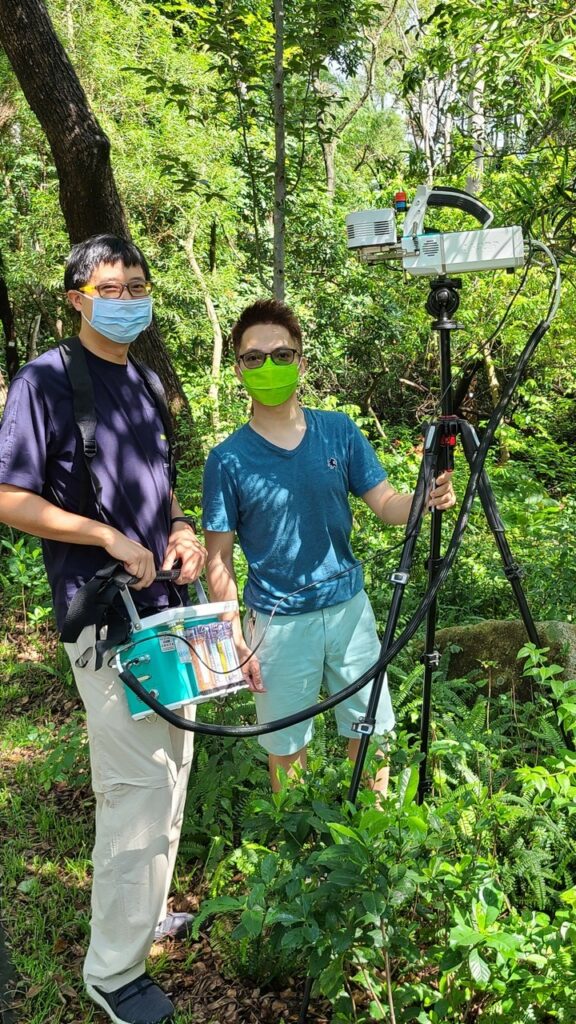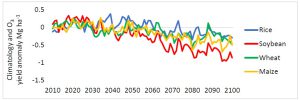CUHK
News Centre
CUHK-led study estimates over one-fifth of staple crops will be lost by 2050 due to ozone pollution and climate change
A study led by The Chinese University of Hong Kong (CUHK) and the University of Exeter’s Joint Centre for Environmental Sustainability and Resilience (ENSURE) projected that yields of the world’s staple food crops will be reduced by up to 22% by 2050 due to the combined impact of ground-level ozone pollution and global climate change. South Asia will be one of the hardest hit regions, as extreme weather events caused by climate change alone will lead to up to 40% less rice being produced by the end of this century.
This study is the first to quantify and estimate the year-to-year integrated impact of ozone pollutants, carbon dioxide (CO2) emissions and climate change on crop yields till 2100. It tells us that global food security and the hunger crisis will get worse, and that action needs to be taken immediately. The findings were published in Environmental Research Letters, a leading journal in the environmental sciences.
Ground-level ozone causes considerable harm to crops
Ozone is mainly produced photochemically from anthropogenic precursor gases such as volatile organic compounds (VOCs) and nitrogen oxides, emitted primarily by vehicles, power plants and industry. Ozone near the ground surface can cause considerable harm to both human and ecosystem health. The phytotoxicity of ozone has been shown to damage photosynthesis, reduce gas exchange, induce early leaf senescence and retard growth in natural vegetation and crops. As plants play vital roles in regulating the ambient environment, ozone-induced damage in plants may further accelerate environmental degradation, with severe consequences for human health.
According to the latest climate analysis[i], the world is on track for 2.4 degrees Celsius of warming by 2100 even if countries around the world can achieve their National Determined Contributions[ii] 2030 targets under the Paris Agreement, and CO2 emissions and ground-level ozone concentrations will likely continue to rise. As plants need CO2 for photosynthesis, this climate- and ozone-driven yield reduction could be partially counteracted by the increased CO2 fertilisation effect but would be limited by the availability of nutrients.
The research team led by Professor Amos Tai, Associate Professor of CUHK Faculty of Science’s Earth System Science Programme and Associate Director of Institute of Environment, Energy and Sustainability (IEES), used the Joint UK Land Environment Simulator (JULES) land surface model with crop-specific ozone damage parameters to quantify the impact of future development due to ozone, CO2 and climate change, and their combined interactions on the yields of four staple food crops: maize, soybeans, wheat and rice. Year 2010 was used as baseline.
Based on the Representative Concentration Pathway 8.5 (RCP8.5)[iii] scenario adopted by the Intergovernmental Panel on Climate Change (IPCC), an obvious declining trend was projected by JULES for all crops’ production yields across decades due to damage by ozone and climate change, but the yield decline was most pronounced in soybeans. Further analysis found that this is because of soybeans’ sensitivity to ground-level ozone damage.
Rice production is most sensitive to climate change-related extreme weather events
The study not only examined the global situation but also focused on major crop-producing regions such as China, the U.S., Brazil, Argentina, India and Europe, enabling it to investigate the importance of each stress factor. For example, soybean yields could be reduced by 22% in China and 42% in the U.S. by 2100.
Another interesting finding is that rice would take the biggest hit from climate change alone, which will put South Asian countries on edge, as they are currently among the world’s largest rice producers. Countries in the area could experience a 10-18% reduction in total crop yields by 2050, and up to a 40% drop by 2100. This risk was brought to public attention when India recently announced that it was banning wheat export due to crop failures from the heatwave and other extreme weather events.
Dr. Felix Leung, Postdoctoral Fellow (honorary) of IEES, first author of the paper and a member of Professor Amos Tai’s research team, commented, “This study demonstrates that the adverse effects of climate change are the single largest factor that contribute to crop yield reduction in the tropical region, especially in rice-producing countries, while ground-level ozone pollution also offsets the CO2 fertilisation effect. We believe this study will contribute to sustainable solutions to end hunger, achieve food security and improve nutrition.”
With international conflicts, global pandemics and economic hardship, food security has already become very fragile, even in developed countries. Climate change and air pollution will only make global food production more unstable, and drive the world away from the UN Sustainable Development Goal of Zero Hunger by 2030. The research team believes that climate mitigation and clean air should combine with technological advancements in crop science in the long run. Continued development of crop cultivars that are heat- and O3-tolerant, and supplemented with nutrients, will help improve food security and human nutrition as the population grows.
The paper can be found here: https://iopscience.iop.org/article/10.1088/1748-9326/ac7246
[i] Climate Action Tracker | Warming Projections Global Update – November 2021
[ii] Nationally Determined Contribution, or NDC, is a climate action plan to cut emissions and adapt to climate impacts. An NDC is a government obligation under the Paris Agreement. 193 parties to the Paris Agreement have issued at least a first NDC and they are required to update it every five years.
https://www.un.org/en/climatechange/all-about-ndcs
[iii] RCPs usually refer to the portion of the concentration pathway extending up to 2100; RCP8.5 is one high pathway, in which radiative forcing reaches greater than 8.5 W m-2 by 2100 and continues to rise for some time. RCP8.5 was intended to be a “very high baseline emission scenario” representing the 90th percentile of no-policy baseline scenarios available at the time (2011). In this scenario, greenhouse gas concentrations will continue to grow at a rate consistent with a high emission future without effective climate change mitigation policies, also known as a high-emission business-as-usual scenario.
Source: https://www.ipcc-data.org/guidelines/pages/glossary/glossary_r.html






